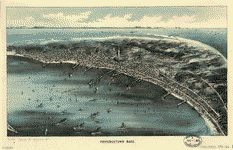|
Hispanic Division: Back to Whaling in Southeastern New England
Bird's-eye View of Provincetown on Cape CodProvincetown, where the Pilgrims first landed at the northeastern tip of Cape Cod, is the American community with the highest percentage of Portuguese residents in its population. They started to settle in Provincetown in the 1850s, and by the 1880s, constituted one-third of the town's population of 6,000. By the middle of the twentieth century, they comprised an absolute majority of the town's residents. Throughout the nineteenth century and the first half of the twentieth century, the town's primary economic activity was fishing. By the beginning of the twentieth century, Portuguese fishermen dominated this industry.Provincetown's maritime location and its role as a fishing port are dramatically portrayed in this early twentieth-century panoramic view. The town's historical significance is also noted with the monument commemorating the Pilgrim's landing prominently displayed in the middle of the town, while Plymouth is shown in the distant background.
101 Independence Ave. SE Washington, D.C. 20540 |
SELECT FROM THE FOLLOWING: Whaling Industry Links Early Nineteenth-Century Portuguese Settlements Jewish Congregation in Colonial Newport, Rhode Island Whaling Industry and Portuguese Immigration Centered in New Bedford, Mass. Portuguese School in New Bedford Bird's-eye View of Provincetown on Cape Cod Cod Fishing in New England Coastal Waters Portuguese Town Fathers in Provincetown Portuguese Settlement in the Fox Point Section of Providence, Rhode Island
|
